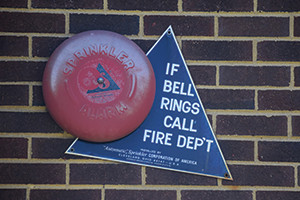Pop quiz: Do you know how many smoke alarms are installed in your house, and when the last time the batteries in them were changed? If you don’t know, don’t worry. We’ve got seven lifesaving smoke alarm safety tips that every parent should know.
Fire safety isn’t something to take lightly. More than one-third of deaths that occur in home fires are a result of no smoke alarms being present, according to the National Fire Protection Agency (NFPA).
But there’s something you can do. The risk of dying in a home fire is cut by 50 percent when working smoke alarms are present, according to the NFPA.
Take these smoke alarm safety steps today to keep your loved ones safe in the event of a fire at your home.
- Install the correct number of smoke alarms for your home
Having one or two smoke alarms in your home just isn’t enough anymore. House fires spread more quickly than in the past thanks to modern materials that burn faster and more easily than natural materials, according to the NFPA.
You should have not only have the right number of smoke alarms present in your home, but should have them installed correctly and in the right places. Smoke alarms are required inside every bedroom, outside each sleeping area, and on every floor of the home.
The NFPA recommends installing smoke alarms:
- On every level of your home
- In each bedroom
- Outside each sleeping area
- In the living room or den, or near stairways
- At the bottom of basement stairs
In the event of a fire, does your family know what to do? Read more about fire escape plans.
- Use both kinds of smoke alarms
There are two kinds of smoke alarms:
Ionization smoke alarms alert you to fires that are characterized by larger flames.
Photoelectric smoke alarms alert you to a different kind of fire, the slower moving kind with smoldering flames and smoke.
Make sure both types of alarms are installed in your home, as you never know which kind of fire could break out. You can also choose a combination alarm, called a dual sensor smoke alarm (or ionization-photoelectric smoke alarm). Such alarms offer better protection by picking up on both types of fires.
- Utilize options for the hard of hearing/hearing impaired
An important aspect of smoke alarm safety is to protect those who are hard of hearing, or hearing impaired, from the risk of fires. This includes the elderly, who may not be able to hear an alarm due to a loss of hearing associated with age.
Smoke alarms with flashing strobe lights offer one way to alert the hearing impaired to a potential fire. In addition, pillow or bed vibration alarms work in conjunction with the smoke alarm to alert someone through feel when the alarm sounds. Not everyone will wake up to the strobe as they would to the feel of vibrations.
For those who have some hearing loss, there are devices that work with smoke alarms to omit a low-pitched noise instead of a high-pitched sound when smoke is detected. A low-pitched noise could be beneficial to those who have a hard time hearing higher pitches.

- Install your smoke alarms properly
Make sure to install smoke alarms at least 10 feet from stoves, other cooking surfaces, and appliances so steam from cooking doesn’t set off the alarms. Also don’t place alarms near doors, windows, or heating ducts that could trigger the alarm falsely.
Because smoke rises, you’ll want to mount smoke alarms on ceilings or high on walls, no lower than 12 inches from the ceiling. If you’re installing an alarm to a pitched roof, place it within three feet of the peak, but lower than four inches from the peak.
- Know when it’s time to replace your alarms
Even if you’ve properly maintained your smoke alarms over the years, including replacing the batteries, alarms should be replaced every 10 years.
- Test your smoke alarms regularly
By regularly, we don’t mean once a year. Once a month is more like it. Press the test button and make sure each alarm is functioning properly. Have you heard a chirping noise coming from your alarm before? That means the batteries are getting low and should be replaced.
No matter if you hear an alarm chirp or not, batteries should be replaced yearly. Do it at the same time each year, and remember by doing it on a family member’s birthday, a special anniversary, or other date you’ll remember. Also use calendar reminders and other electronic alerts to remind you.
Looking for other tech-savvy ways to keep your home safe? Read about home automation and how it benefits home security.
- Keep your smoke alarms properly maintained
Maintenance of your smoke alarms is also important. Painting your ceiling? Don’t just paint over the smoke alarm. Smoke alarms should also be cleaned regularly. Refer to your manual, or the Internet, to learn how.
Give yourself peace of mind that your family is safe by using these smoke alarm safety tips. Do it today!




